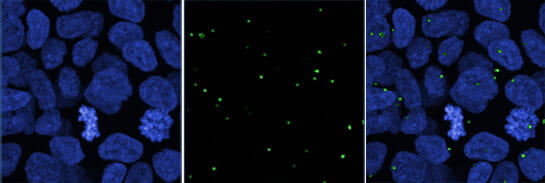Our ready-made tagged organelle cell lines enable real time tracking of protein activity in live cells. These are a great alternative to unreliable antibodies, and are ideal markers to determine:
- The localization of a particular protein or organelle
- Protein interactions
- Protein concentration
For more information or to place an order:
| How do endogenous markers compare to: | Advantages |
| Vectors | No molecular biology capabilities are required |
| Overexpression systems | Protein expression is at the endogenous level, so these tagged cell lines avoid problems with artifacts in fluorescence microscopy, such as ectopic sub-cellular localizations or erroneous formation of protein complexes |
| Conventional gene tagging | Every copy of the gene is tagged making quantification simpler. In conventional methods, untagged versions of a protein may be present. |
| Antibody | Relatively little preparation is required to use the endogenously tagged cell lines, and these are compatible with live cell assays. Unlike antibodies there are no concerns over specificity. |
| Organelle specific dyes | Endogenously tagged cell lines contain an early maturation fluorescence protein allowing for early detection, and so are not dependent on specific organelle conditions for activity. |
Examples of Fluorescent Markers for Cell Organelles
 Organelle: Endoplasmic ReticulumGene tagged: CALRProtein encoded: CalreticulinFunction: Calreticulin is localized to storage compartments associated with the endoplasmic reticulum
Organelle: Endoplasmic ReticulumGene tagged: CALRProtein encoded: CalreticulinFunction: Calreticulin is localized to storage compartments associated with the endoplasmic reticulum
 Organelle: Endoplasmic ReticulumGene tagged: PDIA4Protein: Protein Disulfide Isomerase Family A Member 4Function: PDIA4 is an endoplasmic reticulum luminal protein. This enzyme catalyzes the formation and breakage of disulfide bonds during protein folding.
Organelle: Endoplasmic ReticulumGene tagged: PDIA4Protein: Protein Disulfide Isomerase Family A Member 4Function: PDIA4 is an endoplasmic reticulum luminal protein. This enzyme catalyzes the formation and breakage of disulfide bonds during protein folding.
 Organelle: CentrosomesGene tagged: PCM1Protein: Pericentriolar Material 1Function: The PCM1 gene encodes a component of centriolar satellites, localized adjacent to centrosomes, and plays a pivotal roles in centrosome assembly.
Organelle: CentrosomesGene tagged: PCM1Protein: Pericentriolar Material 1Function: The PCM1 gene encodes a component of centriolar satellites, localized adjacent to centrosomes, and plays a pivotal roles in centrosome assembly.
 Organelle: NucleusGene tagged: h6F3BProtein: h6 Histone, Family 3B (h6.3B)Function: Histones are small basic proteins that package and organize DNA to form nucleosome particles.
Organelle: NucleusGene tagged: h6F3BProtein: h6 Histone, Family 3B (h6.3B)Function: Histones are small basic proteins that package and organize DNA to form nucleosome particles.
 Organelle: NucleusGene tagged: TOP2AProtein: DNA topoisomeraseFunction: This nuclear enzyme controls the topologic states of DNA during transcription, in processes such as chromosome condensation and chromatid separation.
Organelle: NucleusGene tagged: TOP2AProtein: DNA topoisomeraseFunction: This nuclear enzyme controls the topologic states of DNA during transcription, in processes such as chromosome condensation and chromatid separation.
 Orgenelle: MitochondriaGene tagged: HK1Protein: Hexokinase 1Function: This gene encodes a ubiquitous form of hexokinase which localizes to the outer membrane of mitochondria.
Orgenelle: MitochondriaGene tagged: HK1Protein: Hexokinase 1Function: This gene encodes a ubiquitous form of hexokinase which localizes to the outer membrane of mitochondria.
Organelle tagged cell lines
| Location | Protein | Gene |
| Actin | Beta Actin | ACTB |
| Centrosomes | Pericentriolar Material 1 | PCM1 |
| Endosomes | Early Endosome Antigen 1 | EEA1 |
| ER | Calreticulin | CALR |
| ER | Protein Disulfide Isomerase Family A Member 4 | PDIA4 |
| Mitochondria | Hexokinase 1 | HK1 |
| Nucleus | h6 Histone, Family 3B (h6.3B) | h6F3B |
| Peroxisomes | Catalase | CAT |
| Plasma membrane, Cell junctions | Cadherin 2 | CDh4 |
